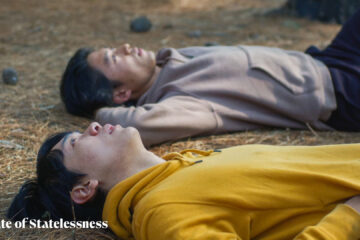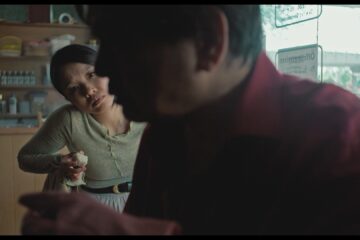In this interview, Thi Dang An Tran, director of Xanh, outlines both her career’s journey from theater to animation filmmaking and her personal experiences as a member of the Vietnamese diaspora in Germany. Drawing inspiration from true events that took place in her father’s restaurant, she explains how animation aesthetics refuels her with a sense of freedom to explore identity formation from different perspectives. She also shares how Vietnamese culture shaped her stylistic choices and enriched her thematic investigation.
Interviewee: Thi Dang An Tran, director of Xanh
Interviewer: Xiangu Qi
Your creative journey began in theater and has now evolved into animated filmmaking. Can you walk us through that transition? What inspired you to take on the project Xanh?
After graduating high school, I had to collect experiences in design and crafting for my plan to study industrial design, so I decided to do some internships in wood construction or metal construction. I majored in drama when I was in school. I became interested in plays and acting anyways so it seemed handy for me to work at a theater that is a set building. Keeping in touch with materials and colors opened new, abstract ways to think about possibilities of simulation. In addition, I was always a fan of animated movies, comics, and illustrations. It also explained why I chose the path I am on now. After I changed my career from design to filmmaking, I remained open to live-action and animation until today. I have the feeling that I can only express myself in animation. As an animation filmmaker, I do not need to express what I have in mind by communicating with the actors. I can choose for myself. I can decide on how to design each character – be it a human, an animal, a form, an object, even the color of sound. Everything can become alive, which is like magic for me.
Being fascinated about the complex sound of the sea, me and my team made Xanh in my second year at the Filmakademie Baden-Wuerttemberg (in Germany). While I was obsessed with the waves and structure of the ocean, I encountered a dark aspect of the ocean. I found some video recordings of the Vietnamese Boat People and was told all the stories of my family – especially my father’s. Once, I went home visiting my parents when my father had a racist encounter with a man. It was not unfamiliar to me. Over the years, I have heard about such moments many times, and I always felt angry and helpless. I always asked myself, “Why don’t you stand up against these racist remarks?”
That became the central question for Xanh. At the very beginning, I wanted my father to be angry, not to remain a victim. After all, I am a daughter and a child who is afraid of the hurt my parents have to endure. I asked my father if he wanted to talk about it as part of the project. I did not know by then what his opinion was, and I learned a lot about the rights to have our own handling. I saw The Midnight Gospel (2020) at the time and found it fascinating to conduct interviews and then animate them. I suggested this to the team as the tone of our project.
Xanh in Vietnamese can mean both “green” or “blue.” How do these double meanings connect to the themes explored in your film?
I am very interested in the Vietnamese language because there are many examples like that. Another example, “Nước” can mean both water or country. For me, it is poetically true that when we look at the sea, it is green and also blue. The waves are beautiful and gentle, but also dangerous and wild. We embed this theme into Xanh through every scene. It is crucial which scene has more blue or green color in it. When watching the film, the audience will get the sense of how traumatizing memories are like and why the father talks about them with a laugh. I don’t want to educate the audience. Rather, I want them to take in information and walk away being more open to different perspectives.
It seems you employed different animation styles for the kitchen scenes and the boat voyage. Could you elaborate on these stylistic choices and what influenced your decision to use each one?
I edited the two-hour recording of talks between my father and I and made it as short as possible. It was important to let my father speak out what was important for him (my father was involved through the filmmaking process until the end). As students with basically no budget we did not aim at winning awards. We could not make a twelve-minute animated film with frame-by-frame lip syncing, but it was fun to find a workaround.
So we took research in Vietnamese art, wooden arts, and papercuts and decided to animate all the memories in a different way from the actual conversation scenes. With that, we had a chance to have the third character present: the little boat, to get us through that delicate yet heavy topic.
The film presents nuanced perspectives on different responses to racism within diasporic communities. How have your own experiences with racism across cultures shaped this narrative – and your broader work as a multimedia artist?
I probably share similar experiences with most second-generation migrant children. Even if I wanted to make a light-hearted film or tell a funny story, I cannot avoid the topics about racism or discrimination. It is a blessing and a curse. However, I want to contribute something to the world. Media platforms provide space and opportunities to interact and gain visibility. I also want to make use of the freedom to write about something that can take me beyond a socially critical stance. Over the years, I’ve realized that love, humor, and dialogue can also be political.
Why did you choose the kitchen as the central setting for the story? What symbolic or thematic role does food play in the film?
I was born and raised in Germany with Vietnamese roots. I am neither German-looking nor fully “authentic” Vietnamese. My understanding of the Vietnamese language is limited, but I know that, “Have you eaten yet?” in Vietnamese culture means much more than consuming food. I grew up with Vietnamese food; it is the greatest legacy I can carry over. I think many people can relate to that. For my German friends it might be their grandmother’s cookie recipe; for me, it is my mother’s Mì Quảng. My father worked in many restaurants. I was a restaurant child. The kitchen was and is the place where my father and I often talked. It was so natural for me to make a kitchen as the setting.
In Xanh, the father makes his favorite dish, Cơm hến. I wanted him to cook something he loves while sharing his story.
For me, the noodle box depicted in this film is a metaphor for identity. So there the little man stands, surrounded by his favorite food, which is associated with many memories of his childhood, wrapped up in a noodle box. That is how Westerners perceive him.
You incorporate visual elements representing different countries – Singapore, Indonesia, the Philippines, and Germany. What guided your selection of these cultural images, and how did you ensure they contributed cohesively to the film’s overall aesthetic?
In Xanh, the focus is never on the country itself, but on the stations where my father and the other refugees wanted to be accepted. We portrayed the rejections of entry as larger boats to show the hopes that were unfortunately dashed. The accommodations in Malaysia were certainly not as paradisiacal as we portrayed them, but we were more interested in my father’s memories and perspective. The way he told the story is his strategy for dealing with it. He was happy about eggs, because he escaped starvation, landed on his feet, escaped drowning, worked in sanitation, and became part of a community. All these joys in life are what I didn’t want to take away from him. It is his story.
What are you currently working on, and what’s next for you? Do you have plans to explore feature-length animation projects in the future?
I graduated with a degree in screenwriting last spring with a feature-length real action script called Redflag. It is a comedy about relationship anarchy, sexuality, interracial love, and dating. I am currently working on an episode for a German crime series. I’m also working in a writers’ room on a series about a Vietnamese family in a restaurant located in Germany. It is about family dynamics and intergenerational conflict.
Xanh won the German Short Film Award in 2023, and my team and I are going to use the prize money to make a new animated film. I am currently working on the initial idea as well. A feature-length animation project would be of course the dream – someday, if I get a chance to write and/or direct one.
Xanh will be shown at the in-person screenings of “Remember My Forgotten Man” on Friday, October 10 at 4 PM and “Best Short Film nominees” on Saturday, October 11 at 10:45 AM at Theater 1 of the Frida Cinema in Santa Ana, California.


